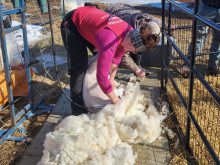Big bottle-shaped teats and those that are deformed or damaged at the tips are at risk because they may let in bacteria
Mastitis is more common and better studied in dairy cattle than beef cows but the latter group aren’t free from the challenges mastitis presents.
“Beef cows with mastitis often have a painful quarter, produce less milk, nurse their calves less, and in some instances infection can lead to septicemia and death of the cow,” says Dr. Jennifer Pearson, assistant professor in bovine health at the University of Calgary’s Faculty of Veterinary Medicine.
Signs of mastitis include swelling, heat, redness and pain. Acute mastitis can cause fever, depression and loss of appetite and weight. It can become chronic if the inflammatory response persists.
“Mastitis organisms are usually classified as contagious or environmental,” says Pearson. “Contagious organisms may be spread by calves cross-sucking from different dams. Environmental organisms invade the udder through unhygienic conditions such as a dirty straw pack.”
Risk factors in older beef cows include abnormal teat conformation and low-hanging udders, but younger cows in contaminated or overcrowded environments can also get it.
“Cows with mastitis may have blood or clots in the milk. In the worst cases, the quarter may be cold, blue and the cow can be off feed and dehydrated from septic shock. Early detection and treatment of mastitis is critical for the cow and calf,” Pearson says.
Large pendulous udders are at greater risk of infection. Big bottle-shaped teats, and teats deformed or damaged at the tips, may let in bacteria.
Mastitis can develop in response to tissue damage to the teat or udder. Abrasions, lacerations or bruising, wind burn or frost damage are factors. Windy, cold weather may cause chapped, cracked skin and teats become so sore that the cow won’t allow its calf to nurse.
Dr. Shelie Laflin, a Kansas veterinarian, says mastitis often occurs in heavy-milking beef cows that produce more milk than their calves can ingest.
“This can lead to the teat orifice remaining open, more vulnerable to environmental pathogens,” she says.
Dairy cows have higher risk because their larger mammary glands and udders are frequently handled.
“Automatic milkers cause the teat orifice to open and the teats are handled by humans, exposed to more pathogens than in a calf’s mouth,” Laflin said.
“If a beef cow is giving too much milk for her newborn calf, you might keep her from getting mastitis by milking her out for a day or two until the calf can take all the milk. In some cases you might graft an extra calf onto her for a while, if you have an orphan calf.” The goal is to keep the quarters empty so teats can close and pathogens can’t enter.
If the cow lies in manure or walks through deep mud, the calf may refuse to nurse and quarters become large and at greater risk for bruising.
“If another cow steps on her teat or it gets snagged in the brush or on a fence, the teat end may be damaged so it can’t close properly, and pathogens enter,” said Laflin.
If infection is localized, the mammary tissue in that quarter may be destroyed but the infection is not life-threatening. If permanently damaged, a quarter will dry up.
However, if infection reaches the bloodstream, the cow can lose part of the udder or even die.
Selecting cows with tight udders and small teats helps prevent suckling problems and lowers mastitis risk.
Kajal Devani, director of science and technology at the Canadian Angus Association, says several breed associations use Beef Improvement Federation guidelines for udder scores.

“If the udder doesn’t have good suspensory support, it becomes pendulous as the cow ages, hanging below the hock,” Devani says, noting a large, low-hanging udder is more vulnerable.
“The ultimate goal is cow longevity. We want good cows to stay in the herd a long time.
“Heritability for udder score is approximately 30 percent, which means that 30 percent of the variation we see in udder structure is genetic,” Devani says.
Producers should identify cows that maintain good udder and teat scores as they age and use them as breeding stock for replacement heifers or bulls. The udder score on a bull’s mother is important for the traits it passes to daughters.
“We want to identify the cows that start out with good udders and keep them, versus the ones that lose suspensory support and have pendulous udders as they get older.”
Bad udders are among the most common reasons to cull cows. A dirty environment at calving time, however, exposes even a good udder to pathogens.
“We collect teat and udder scores annually at calving,” says Devani. “It pays to record these things at calving time because later on the udder may look fine. We tend to forget what it looked like when she calved. The BIF teat and udder scoring guidelines are available online if people want to look at those.”
There are intra-mammary treatments for mastitis but “the challenge is that this requires multiple treatments. It’s not as easy to restrain and treat the beef cow twice daily,” says Laflin.
“This is still the treatment of choice, however, along with keeping that quarter empty — milking it out at least twice a day and then infusing the medication.”
Pearson also recommends frequent milking, anti-inflammatory medications to treat pain and inflammation and an antibiotic given either systemically or in the affected quarter. “Working with your veterinarian is critical to select an appropriate antibiotic for bacterial infection, and to develop an appropriate treatment protocol,” Pearson says.
Adds Laflin: “Systemic treatment isn’t needed unless a cow is systemically ill. Environmental pathogens like E. coli or klebsiella can make the cow very sick. Then you must treat immediately with the appropriate antibiotics. These can be aggressive pathogens, killing a cow in a matter of about 12 hours.”

















